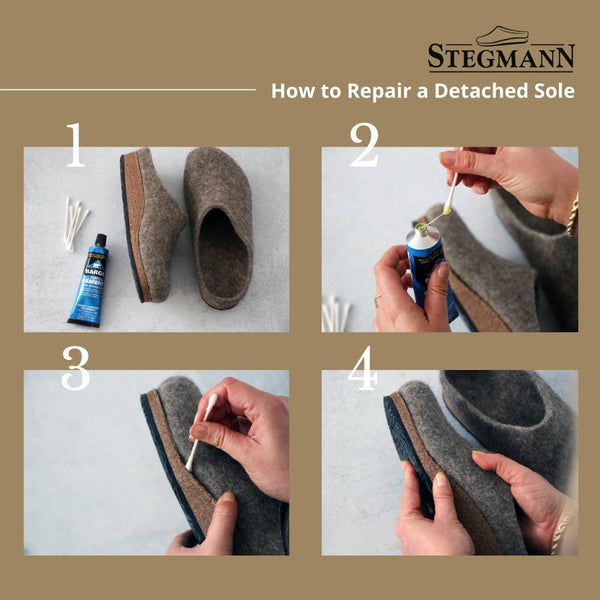From our chic leather boots to our cozy wool shoes, we carefully select the materials that make it to the shoes on your feet. Not only do we look for high quality materials, but we are careful to chose materials that allow us to extend our sustainability and species preservation efforts.

For example, when it comes to wool, we source natural wools of varying colors and textures to create color depth. In the process, we narrow our selection to wools from rare species, which helps preserve their populations. When it comes to our leather footwear, our tannery in Portugal is a rated member of the Leather Working Group and is Chrome Free. The people we work with are impressive, and we think the shoes we create are, too.
As you wear your Stegmann shoes, they will be confronted by rain, dinner time stains, animal encounters, and, of course, your feet! Sometimes your shoes will need a bit of love. A sustainable lifestyle means giving your shoes that extra love so you can keep wearing them--it’s better to repair than to replace! With a few tricks of the trade, your Stegmann shoes can last many years. Below are a few tips and tricks to refresh your shoes when they’ve had a rough day.
How to Clean your Wool Clogs
Over time, wool will attract debris, pet hair, and pills. Just like your nice wool sweaters, your Stegmann clogs will need some TLC from time to time. Your shoes are not machine washable, but you can keep your shoes looking fresh and clean with a simple felt care brush.
The felt brush is easy to use. Start by holding the brush firmly in your hand. Begin brushing in one direction and you’ll begin to see debris disappear or attach to the brush. Brush your wool shoes as long as needed to remove all signs of debris and pills. You can repeat this as often as you need to keep your wool shoes fresh and ready for action! Shop the Stegmann Felt Care Brush.
Stains can be removed with a gentle soap and warm water. Spot clean only, and don't saturate your shoes as that will weaken to adhesive. Which brings us to our next topic...
How to Repair your Sole if it Detaches

Stegmann wool clogs are constructed differently than most shoes because our process keeps the wool upper completely free of seams. We do this so our shoes are free of stitching that could rub or irritate your feet over time. We adhere the uppers of your shoes to the cork or rubber soles with a very strong adhesive. This adhesive usually holds for years and years, but sometimes the adhesive and the wool undergo a process called “de-lamination.” This means the upper may begin to separate from the sole of your shoe. This is caused by heat, humidity, water, or other factors that can begin to break down the adhesive. The shoes are not defective, the adhesion simply has been weakened. Fortunately, it is very simple to fix! Reach for Barge’s All-Purpose Cement-- we have tried it on our own Stegmann shoes and highly recommend it!
How to Use It:
Before you start, please read the instructions on the Barge container. Below is our step by step advice.
1: Make sure you are in a well-ventilated area or can open a window.
2: Wipe down the surfaces around the affected area with a dry or damp cloth to ensure no debris will be tracked into the shoe with the glue.
3: Have a few q-tips or a knife as tools to apply the all-purpose cement.
4: Open the top of the Barge’s container and squeeze a small amount onto the q-tip or tool.
5: Separate the affected area as much as possible. Use the tool to push the glue between the sole and upper. Apply to both sides and wait 15 -20 minutes to allow the adhesive to absorb fully to each side.
6: Wipe away any excess glue on the exterior immediately with a damp cloth.
7: Per the Barge instructions: Wait 15-20 minutes to allow the adhesive to cure before applying pressure.
8: Apply pressure: Slide your hand inside of the shoe and press down on the affected area either by setting it on the floor or with the other hand. Press down and hold for 10-15 minutes. You may also gently slide your foot in and stand in the shoe to apply pressure - but do not move or walk.
9.The adhesive will need to cure for several hours at room temperature and low humidity to ensure proper adhesion. If you can clamp or weight the clog to maintain pressure as it cures, we recommend you do so.
For more photos and detailed instructions on how to repair your sole with Barge cement, please see our Clog & Shoe Care Page.
How to Clean your Leather Clogs or Shoes
The leather for shoes like the Chelsea Boot is sourced and produced in Portugal. The leather is vegetable-tanned and durable. They are shaped for a long-lasting and comfortable fit. Your leather shoes can become stained overtime as you wear them day in and day out. As you find stains adding up, give your leather shoes a good cleaning. We recommended our Apple Leather Cleaning and Conditioning products
To start the cleaning process, wipe down the surface of your shoes with a dry cloth to remove any extra debris and dirt. Then, spray the leather cleaner on a soft bristle brush or sponge--don’t spray it directly on the shoe. Wipe the entire leather upper of the shoe and be sure to focus on the tough-stained areas. For an even result, cover the entire leather surface with the leather cleaner. Then, follow the cleaning with a leather conditioner to prevent the shoe from drying out. As you did with the cleaner, place the conditioner on a sponge and wipe down the entire surface.
Once you’re finished, allow the area to dry for 30 minutes. Follow the process up with the Apple Leather Protectant Spray to protect your shoes for the months of fun ahead


